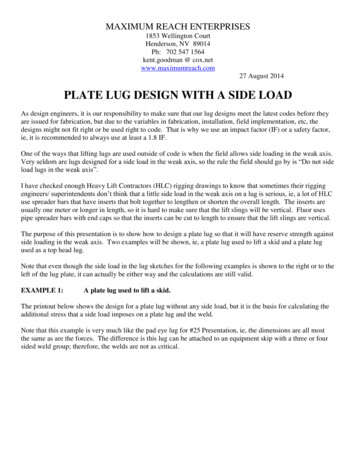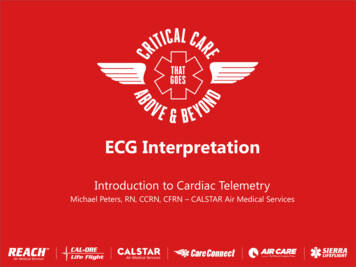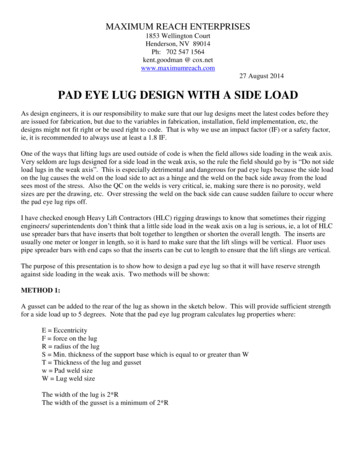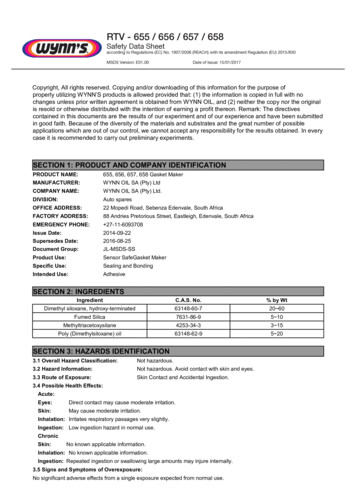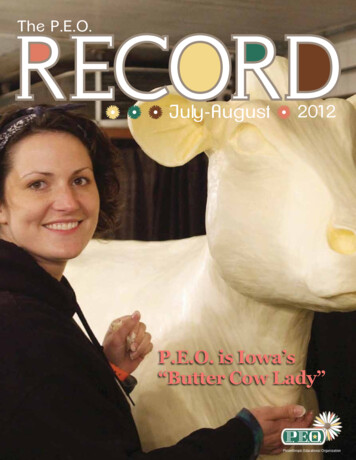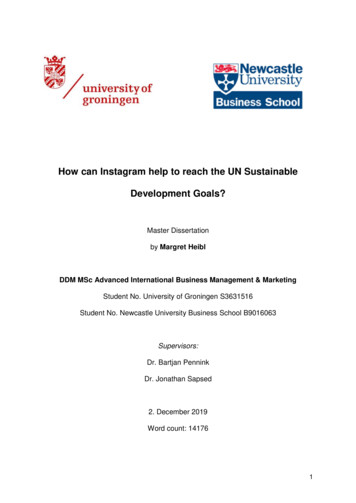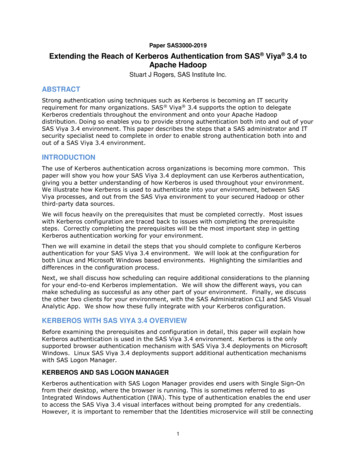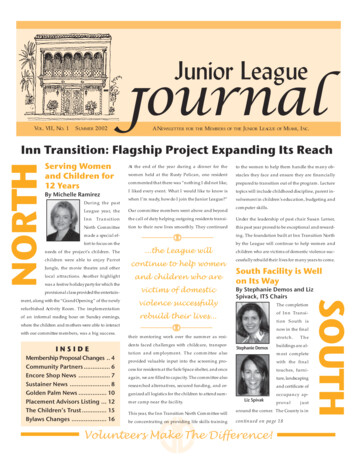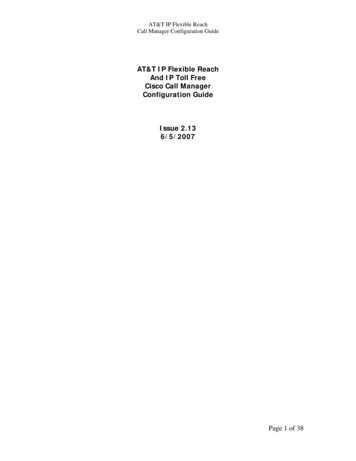
Transcription
AT&T IP Flexible ReachCall Manager Configuration GuideAT&T IP Flexible ReachAnd IP Toll FreeCisco Call ManagerConfiguration GuideIssue 2.136/5/2007Page 1 of 38
AT&T IP Flexible ReachCall Manager Configuration GuideTABLE OF CONTENTS1234567Introduction. 3Special Notes . 3Overview. 43.1Call Manager Site . 43.2TFTP and DHCP Configuration Guidelines . 4Configuration Guide . 54.1Call Manager Version . 64.2Dual AT&T Border Element Connection . 84.2.1Gateway . 84.2.2Route Group. 114.2.3Route List. 134.2.4Route Pattern. 144.3Calling Party Number Translation Configuration. 164.4Incoming Call Routing on Telephone Number. 184.5Region - WAN . 204.6Region – Default . 214.7Device Pool – WAN . 224.8Device Pool – Default. 234.9Media Resource Group . 244.10 Media Resource Group List . 254.11 Conference Bridge . 264.12 Transcoder. 274.13 Phone Configuration . 284.14 Service Parameters. 29IP Toll Free Specific Information . 305.1Call Flow with IP Call Center. 305.2Examples for Call Manager Configuration for IPCC . 325.2.1CTI Route Points. 335.2.2Incoming Call Routing for IP Toll Free. 345.2.3JTAPI User Definitions. 35Appendix A: Router Version/Configuration for Transcoding . 366.1Router Version . 366.2Transcoding Configuration . 36Appendix B: Firewall Rules. 37Page 2 of 38
AT&T IP Flexible ReachCall Manager Configuration Guide1 IntroductionThis document provides a configuration guide to assist Cisco Call Manageradministrators in connecting to AT&T IP Flexible Reach Services and IP Toll Free.2 Special NotesEmergency 911/E911 Services LimitationsWhile AT&T IP Flexible Reach services support E911/911 calling capabilities incertain circumstances, there are significant limitations on how these capabilitiesare delivered. Please review the AT&T IP Flexible Reach Service Guide in detailto understand these limitations and restrictions.Fax Not Supported on G.729 CallsCustomers using the AT&T IP Flexible Reach Service generally use the G.729Codec for voice calls. When a customer makes a fax call rather than a voice call,IP Flexible Reach service detects this fax tone and converts the call to the G.711ulaw Codec. This codec provides greater reliability than G.729 for fax calls. Thischange to G.711 however is not currently supported by Cisco on H.323 trunks.Unity Voice Mail Access Does Not Work From a TDM PBX SiteUnity Voice Mail access from a TDM PBX with a SIP gateway in the AT&Tmanaged router (i.e. with IP Long Distance or IP Flexible Reach Service) is notsupported. Unity Voice Mail access works fine from a PSTN endpoint.Certain Unattended Transfers to the PSTN Result in No Ring BackCertain unattended transfers to PSTN endpoints do not return ring back prior toconnect.Page 3 of 38
AT&T IP Flexible ReachCall Manager Configuration Guide3 OverviewThis section provides a service overview of the Cisco Call Manager integrationwith AT&T IP Flexible Reach. The components are shown next.PSTNPrivate SidePublic erElementAT&TManagedRouterWith NATCall Manager IP PBXIP BorderElementCisco routerWithVoice GWLegacyCircuitPBX3.1 Call Manager SiteThe Call Manager site consists of the following components. Cisco phones (customer managed) – These may be hard phones or softphones. Cisco switch (customer managed) – This is the Cisco switch to provide powerto the phones. Call Manager IP PBX (customer managed) – This is the Call Manager server. AT&T Managed Router (AT&T managed) – This is the router managed byAT&T. The router shall perform packet marking and QOS for voice. Thisrouter will support NAT (dynamic NAT for the phones, static NAT for the CallManager) in the VoPNT VPN configuration. IOS 12.4.6T6 is recommended inorder to support the TCP keep alive functions in Call Manager.3.2 TFTP and DHCP Configuration GuidelinesThe guidelines must be followed for TFTP configuration. Phones at the CallManager must have their TFTP server set to the private address of the localCall Manager. This can be configured in the DHCP server used by the CallManager site phones.Page 4 of 38
AT&T IP Flexible ReachCall Manager Configuration Guide4 Configuration GuideThis configuration guide specifies the Call Manager screens that must beconfigured and updated to support the AT&T IP Flexible Reach.Page 5 of 38
AT&T IP Flexible ReachCall Manager Configuration Guide4.1 Call Manager VersionFor IP Flexible Reach, the Call Manager must be running one of the followingreleases: 4.1.(3), 4.2.(1), or 4.2.(3). The most recent service release isadequate. (See section 5 for IP Toll Free requirements.) You can check theversion of Call Manager from the about option on the help menu and thenselecting details as shown next.Page 6 of 38
AT&T IP Flexible ReachCall Manager Configuration Guide4.2Page 7 of 38
AT&T IP Flexible ReachCall Manager Configuration GuideDual AT&T Border Element ConnectionThis section describes the procedure for connecting to dual AT&T BorderElements.4.2.1 GatewayThis screen specifies the parameters for connecting to each of the AT&T BorderElements. Two gateways must be configured (i.e. one for each border element).Note that only border element is shown. It is accessed from the Device menu.Key parameters are:Device Name: This is the IP address of the AT&T Border Element specified inthis gateway screen. Two gateway screens are recommended (one for eachAT&T Border Element). Sample IP addresses are shown in the screens.PLEASE CONTACT YOUR CUSTOMER CARE REPRESENTATIVEFOR THE AT&T IP BORDER ELEMENT IP ADDRESSES FORYOUR SPECIFIC PBX.Device Pool: Device pool points to a region that specifies the codec and mediaresources (e.g. conference bridge, transcoder, etc) to be used.Significant Digits: Number of right most digits that will be extracted from thecalled number. For the virtual telephone number (VTN) feature, this fieldmust be set to ALL.Wait for Far End H.245 Terminal Capability Set – This field must beunchecked.Enabled Inbound FastStart: This specifies that the Call Manager can acceptthe H.323 fast start element in the call setup messages.Calling Party Presentation – Must set to “Allowed”.Caller ID DN – Set this to the phone number prefix for this site. Call Managerwill prepend this string to the extension when the calling number is generated.Calling Search Space – If the Call Manager phones are assigned to a callingsearch space, then the calling search space on the gateway form must be set tothe same value.Page 8 of 38
AT&T IP Flexible ReachCall Manager Configuration GuidePage 9 of 38
AT&T IP Flexible ReachCall Manager Configuration GuidePage 10 of 38
AT&T IP Flexible ReachCall Manager Configuration Guide4.2.2 Route GroupThe route group specifies a set of alternate routes. If the connection to oneAT&T Border element fails, Call Manager will attempt a connection to the otherborder element. It is accessed from the Route Plan menu. Key fields are:Route Group Name: This is name of the route group.Distribution Algorithm: Set this to top down. The first BE will be primary andthe second will be backup.Selected Devices: These are the gateway devices previously configured.Page 11 of 38
AT&T IP Flexible ReachCall Manager Configuration GuidePage 12 of 38
AT&T IP Flexible ReachCall Manager Configuration Guide4.2.3 Route ListIn order for the route group to be used in a route pattern, a route group must beput in a route list. It is accessed from the route plan menu. Key fields are:Route List Name: The name of the route list.Selected Groups: This is the route group previously defined for the 2 AT&TBorder Elements.Page 13 of 38
AT&T IP Flexible ReachCall Manager Configuration Guide4.2.4 Route PatternThis screen specifies the called number patterns that should be used todetermine which calls are to be sent to the AT&T IP Flexible Reach. It isaccessed from the Route Plan menu. Multiple route patterns may need to beconfigured (e.g. for site to site, US offnet and international offnet calls). Keyfields include:Route Pattern: Specifies the dialing prefix and called number match.Gateway/Route List: Must be set to the route list configured for the dualAT&T Border Elements.Prefix Digits: These digits will be pre-pended to the calling party extension.The next section describes how to configure a calling party number translationfrom an internal extension to a completely different external number.Discard Digits: Discard the dialed digits before the dot.Page 14 of 38
AT&T IP Flexible ReachCall Manager Configuration GuidePage 15 of 38
AT&T IP Flexible ReachCall Manager Configuration Guide4.3 Calling Party Number Translation ConfigurationThis section specifies how to configure a calling party number translation from aninternal extension to a completely different external number. This configurationis required for the Virtual Telephone Number (VTN) feature.On the directory number screen for the internal extension, set the ExternalPhone Number Mask to the desired external calling party number.Page 16 of 38
AT&T IP Flexible ReachCall Manager Configuration GuideOn each route pattern used to route to the AT&T network, check the UseCalling Party’s External Phone Number Mask field. You must remove theentries in the other calling party transformation fields.Page 17 of 38
AT&T IP Flexible ReachCall Manager Configuration Guide4.4 Incoming Call Routing on Telephone NumberWhen using the AT&T Virtual Telephone Number feature (VTN), the AT&Tnetwork will send the call to the PBX using a full E.164 public number. Thisnumber can be mapped to an internal extension on the following screen.When using a non virtual Telephone Number, the AT&T network will send thecall to the PBX using 7 digits or less as requested by the customer.On the translation pattern screen, put the called number sent from AT&T in thetranslation pattern field and put the internal extension in the called partytransform mask field. This example maps the public called number“7323684812” to the internal extension “6004” for internal routing.Page 18 of 38
AT&T IP Flexible ReachCall Manager Configuration GuidePage 19 of 38
AT&T IP Flexible ReachCall Manager Configuration Guide4.5 Region - WANThe region specifies the codec to be used for devices that point to this region.This particular region is used by devices associated with the AT&T BorderElements. This screen is accessed from the system menu. Key fields are:Default: Specifies that the G.729 codec to be used with the default region.WAN: Specifies that the G.729 codec to be used with other devices in thisregion.Page 20 of 38
AT&T IP Flexible ReachCall Manager Configuration Guide4.6 Region – DefaultThe region specifies the codec to be used for devices that point to this region.This particular region is used by devices associated with non AT&T components(i.e. phones). This screen is accessed from the system menu. Key fields are:Default: Specifies that the G.711 codec to be used with the default region. Thismeans that G.711 will be used between the Call Manager phones at this site.WAN: Specifies that the G.729 codec to be used with devices in the WAN region.This means that G.729 will be used between the Call Manager phones and anyendpoint reach via the AT&T Border Element.Page 21 of 38
AT&T IP Flexible ReachCall Manager Configuration Guide4.7 Device Pool – WANThe device pool specifies parameters to be used by devices that point to thisdevice pool. This particular device pool is used by devices associated with theAT&T Gatekeeper. This screen is accessed from the system menu. Key fields are:Region: The region specifies the codec to be used for this device pool.Media Resource Group List: This points to a media resource group thatspecifies media resources (i.e. conference bridges, transcoders, etc) to be usedfor this device pool.Page 22 of 38
AT&T IP Flexible ReachCall Manager Configuration Guide4.8 Device Pool – DefaultThe device pool specifies parameters to be used by devices that point to thisdevice pool. This particular device pool is used by devices associated with nonAT&T components (i.e. phones). This screen is accessed from the system menu.Key fields are:Region: The region specifies the codec to be used for this device pool.Media Resource Group List: This points to a media resource group thatspecifies media resources (i.e. conference bridges, transcoders, etc) to be usedfor this device pool.Page 23 of 38
AT&T IP Flexible ReachCall Manager Configuration Guide4.9 Media Resource GroupThe media resource group specifies a grouping of media resources (i.e.conference bridge, transcoder, etc). This particular media resource groupcontains a conference bridge and a transcoder. This screen is accessed from theservice/media resource menu. Key fields are:Selected Media Resources: Points to profiles for conference bridge (CFB) andtranscoder (XCODE) resources to be used in this group.Page 24 of 38
AT&T IP Flexible ReachCall Manager Configuration Guide4.10 Media Resource Group ListThe media resource group list is a grouping of media resource groups. Thisscreen is accessed from the service/media resource menu.Page 25 of 38
AT&T IP Flexible ReachCall Manager Configuration Guide4.11 Conference BridgeThe conference bridge specifies the conferencing resources to be used by theCall Manager phone users when the phone’s conference button is selected. Thisscreen is accessed from the service/media resource menu.Page 26 of 38
AT&T IP Flexible ReachCall Manager Configuration Guide4.12 TranscoderThe transcoder specifies the transcoding resources to be used to convert fromthe G.729 to G.711 codecs for conference calls that include a call leg to theAT&T IP Flexible Reach. This screen is accessed from the service/media resourcemenu. Key fields include:Host name: This is a pointer to the transcoding resource. The host name is thestring “MTP” followed by the MAC address of the Cisco router or switch with theDSP resources being used for transcoding.Page 27 of 38
AT&T IP Flexible ReachCall Manager Configuration Guide4.13 Phone ConfigurationThis screen specifies the parameters for the Call Manager phones. It is accessedfrom the Device menu. Key parameters are:Device Pool: This phone will use the parameters in the “default” device pool.Media Resource Group List: This phone will use the resources specifies in thedesignated Media Resource Group List which include the conference bridge andtranscoder.Page 28 of 38
AT&T IP Flexible ReachCall Manager Configuration Guide4.14 Service ParametersThis screen specifies the parameters for the Call Manager. It is accessed fromthe Service menu.The full list of service parameters are in the following attachment.Cisco Unified CallManager 4 2 Administration - Service Parameters Configuration.mhtKey parameters are:H225 TCP Timer: This specifies the amount of time Call Manager will wait aftertrying to open an H225 channel with the AT&T Border Element before attemptingan alternate route.Check Progress Indicator Before Establishing Media: This parameterspecifies that Call Manager must check the progress indicator in an alerting orprogress message prior to establishing a media channel. This parameter must beset to “true”.Max Call Duration: This parameter specifies how long a call should last inminutes. The default is 720 (i.e. 12 hours). AT&T recommends that thisparameter be set to “0” (no max call duration limit).Duplex Streaming: This parameter specifies whether 2 way voice streamingwill occur when music on hold is implemented. AT&T requires that the defaultsetting of “true” be used.Page 29 of 38
AT&T IP Flexible ReachCall Manager Configuration Guide5 IP Toll Free Specific InformationThis section provides information specific to IP Toll Free.5.1 Call Flow with IP Call CenterThis section provides a typical call flow for the interaction between the AT&T IP TollFree Service and the Cisco IP Call Center. Note that Cisco CVP (Cisco Voice Portal)is NOT currently supported. The components in this call flow include the following: Call Manager - Call Manager is the Cisco IP PBX platform. Call Manager release4.2.1 is supported for this application.IP IVR – IP IVR is the Cisco IVR platform. This platform is used to play voiceprompts as needed based on information based from ICM. IP IVR release 4.0.4 issupported for this application.ICM – ICM is an IPCC scripting application. This application is used to script theflow of a customer’s IPCC application. ICM release 7.0 SR4 is supported for thisapplication.Page 30 of 38
AT&T IP Flexible ReachCall Manager Configuration GuideThis call flow is shown in the following figure.ICM4, 7PublicNetwork71IP3675AT&TBVOIPN tk5 ,1010Call Manager1052IPTDMCallControl11CallAnsweredIP Phones & Agent DesktopsThe steps in a typical call flow are described next.1. Call delivered from PSTN to AT&T BVOIP network.2. AT&T BVOIP network sends H.323 setup to Cisco CallManager. The AT&Tnetwork will always send these calls to Call Manager,3. Based on the called number, a JTAPI Route Request is sent to the ICM.4. ICM runs a routing script. Based on the routing script, ICM determine what to donext. For example, if no available agent is found, the IP IVR label is returned fromrou
change to G.711 however is not currently supported by Cisco on H.323 trunks. Unity Voice Mail Access Does Not Work From a TDM PBX Site . Unity Voice Mail access from a TDM PBX with a SIP gateway in the AT&T managed router (i.e. with IP Long

